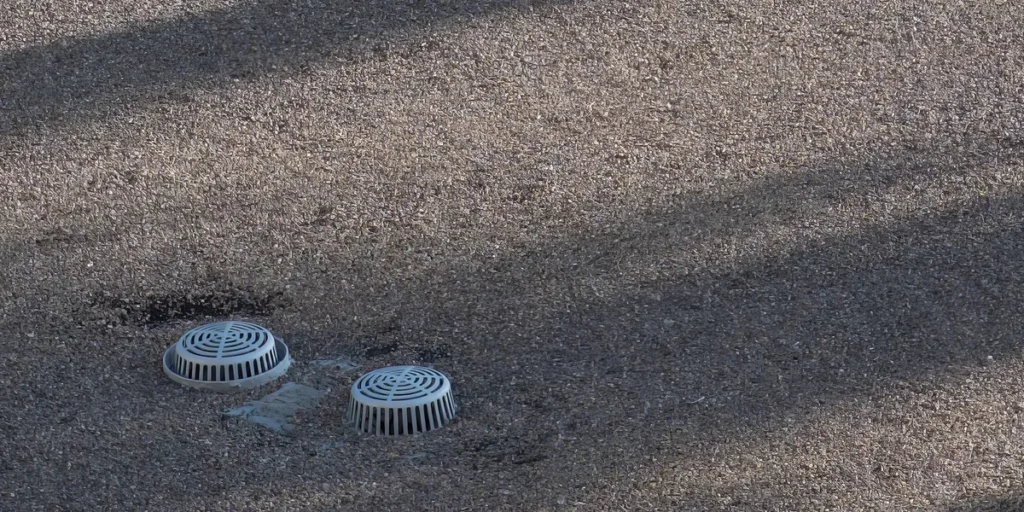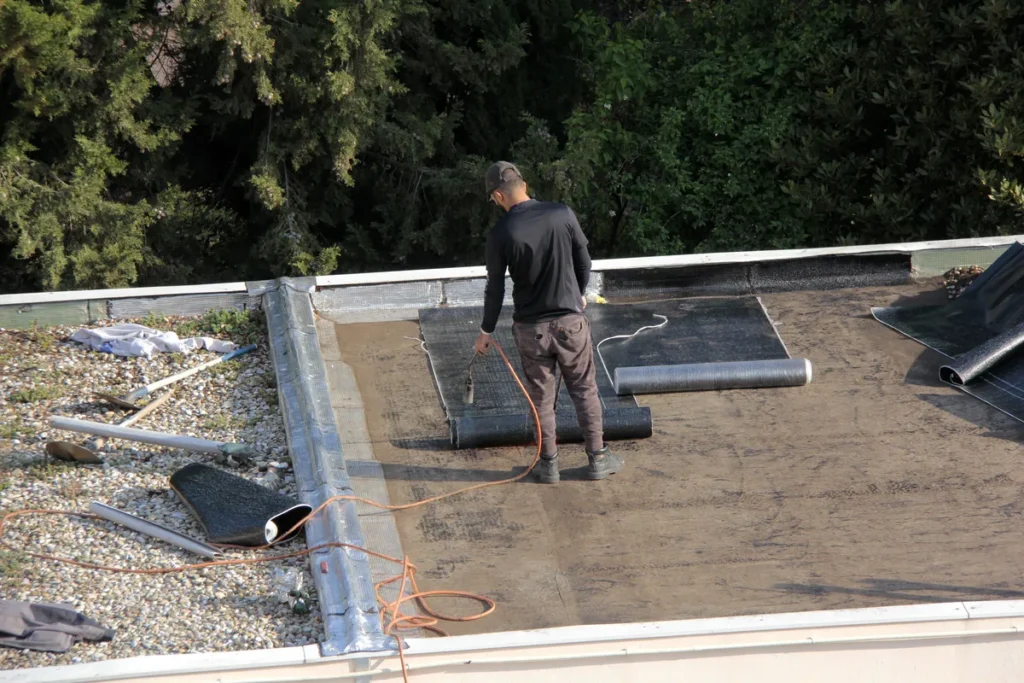Tar And Gravel Roof: Which One Is Right For You?
Posted: August 27, 2024
You have plenty of options to choose from to find the right roofing material for your building. One option that often goes under the radar is the tar and gravel roof, but it offers unique benefits that might just make it the perfect choice. In this blog post, we’ll explore the ins and outs of tar and gravel roofs, covering everything you need to know to make the best decision for your roof, including:
- What is a Tar and Gravel Roof?
- Benefits of Tar and Gravel Roofs
- Cost Analysis of Tar and Gravel Roofs
- 5 Factors to Consider Between Tar and Gravel Roof Materials
- Common Misconceptions About Tar and Gravel Roofs
- Maintenance Tips for Tar and Gravel Roofs
- Longevity and Durability of Tar and Gravel Roofs
🤔 What is a Tar and Gravel Roof?

A tar and gravel roof, also known as a built-up roof (BUR), is a type of flat roofing system. It consists of several layers of bitumen (tar) alternated with layers of reinforcing fabric. The top layer is covered with a layer of gravel or other aggregate material to protect the underlying layers from UV rays and physical damage.
History and Evolution
Tar and gravel roofs have a rich history, dating back over a century. Their rise in popularity during the early 20th century can be attributed to their exceptional durability and cost-effectiveness, making them an attractive choice for builders and property owners alike.
- Durability: Known for their long-lasting performance.
- Cost-Effectiveness: A budget-friendly roofing option.
- Material Advancements: Inclusion of modified bitumen for improved quality.
- Installation Improvements: Enhanced techniques for better reliability.
As the construction industry evolved, so did these roofing systems, adapting to changing industry standards and consumer needs.
Modern Applications
In contemporary construction, tar and gravel roofs are primarily found on commercial buildings due to their robust performance in a variety of conditions. However, they are also gaining traction in residential markets as homeowners seek durable and cost-effective roofing solutions. These roofs are especially well-suited for flat or low-slope designs, where traditional shingles may struggle. Their excellent waterproofing capabilities and superior insulation properties make them an ideal choice for energy efficiency, helping to regulate indoor temperatures and protect structures from the elements.
✅ Benefits of Tar and Gravel Roofs
Choosing the right roofing material is crucial for the longevity and performance of your property. Here are some of the key benefits of opting for a tar and gravel roof:
Durability: One of the standout features of tar and gravel roofs is their durability. The multiple layers of bitumen and fabric create a robust barrier against the elements, ensuring your roof can withstand harsh weather conditions.
Cost-Effectiveness: Tar and gravel roofs are generally more affordable than other roofing options. The materials are cost-effective, and the installation process is relatively straightforward, which helps keep labor costs down.
Energy Efficiency: The reflective surface of the gravel helps to reduce heat absorption, making your property more energy-efficient. This can lead to lower cooling costs during the hot summer months.
💵 Cost Analysis of Tar and Gravel Roofs

Understanding the cost of a tar and gravel roof is essential for making an informed decision. Here’s a breakdown of the typical expenses associated with this roofing system:
Material Costs: The cost of tar and gravel roof materials can vary depending on the quality and quantity required. On average, you can expect to pay between $3 and $5 per square foot for materials.
Installation Costs: Labor costs for installing a tar and gravel roof can also vary. On average, installation costs range from $2 to $4 per square foot. It’s important to hire a reputable contractor to ensure the job is done correctly.
Maintenance Costs: Regular maintenance is crucial for the longevity of your roof. Budget for periodic inspections and minor repairs to keep your roof in top condition. Maintenance costs are generally reasonable and can significantly extend your roof’s life.
👉 5 Factors to Consider Between Tar and Gravel Roof Materials
Choosing between tar and gravel roof materials involves several factors. Here’s a numbered list to help you make an informed decision:
1. Climate:
When choosing a tar and gravel roof, it’s crucial to account for your local climate. While these roofs are versatile and perform well under various weather conditions, they can struggle in extremely cold environments where snow and ice accumulation may pose challenges. Additionally, in regions with heavy rainfall, proper drainage systems must be in place to prevent water pooling.
2. Roof Slope:
Tar and gravel roofs are ideal for flat or low-slope designs, as they allow for effective water drainage. However, if your roof has a steep slope, this type of roofing may not be suitable. It’s important to assess the slope of your roof to ensure that it aligns with the installation requirements for tar and gravel systems, as improper installation can lead to leaks and other issues.
3. Budget:
Establishing a clear budget is essential when considering tar and gravel roofs. While the initial cost may be lower compared to other roofing options, it’s important to factor in the total expenses associated with materials, installation, and ongoing maintenance. Understanding the long-term financial implications will help you make a more informed decision and avoid surprises down the road.
4. Longevity:
The durability of roofing materials is a significant factor in your decision-making process. Tar and gravel roofs can last up to 30 years when properly maintained, making them an attractive option for homeowners seeking longevity. Regular inspections and maintenance can extend their lifespan, so it’s vital to consider your willingness to commit to the upkeep required for optimal performance.
5. Environmental Impact:
Assessing the environmental impact of roofing materials is increasingly important. Tar and gravel roofs can be made from natural materials, and many manufacturers offer bitumen products with eco-friendly formulations. By evaluating the sustainability of the materials used, you can make a choice that aligns with your environmental values while still meeting your roofing needs.
🚫 Common Misconceptions About Tar and Gravel Roofs
There are several misconceptions about tar and gravel roofs that may deter homeowners from considering them. Let’s debunk some of these myths:
They’re Outdated
While it’s true that tar and gravel roofs have been around for a long time, modern advancements have made them more efficient and reliable than ever. They continue to be a viable roofing option for many homes and businesses.
They’re High-Maintenance
Some people believe that tar and gravel roofs require constant upkeep. In reality, they need no more maintenance than other roofing systems. Regular inspections and minor repairs can keep them in excellent condition for decades.
They’re Not Aesthetically Pleasing
A common misconception is that tar and gravel roofs lack visual appeal. However, the gravel layer can be customized with different colors and materials to enhance the overall look of your property.
💡 Maintenance Tips for Tar and Gravel Roofs

Like any roofing system, tar and gravel roofs require regular maintenance to ensure they remain in good condition. Here are some tips to help you keep your tar and gravel roof in top shape:
- Regular Inspections: Conduct regular inspections to check for any signs of damage or wear. Look for cracks, blisters, or areas where the gravel cover is thinning. Address any issues promptly to prevent further damage.
- Cleaning: Keep the roof clean by removing any debris that accumulates. This includes leaves, branches, and dirt. A clean roof is less likely to develop issues and will perform better over time.
- Professional Maintenance: Schedule periodic maintenance with a professional roofing contractor. They can perform more thorough inspections and make any necessary repairs to ensure your roof remains in optimal condition.
- Proper Drainage: Ensure that gutters and downspouts are clear and functioning correctly to prevent water from pooling on the roof. Standing water can lead to damage over time.
- Check for Vegetation Growth: Inspect for any moss, algae, or plants growing on the roof. Remove any vegetation promptly, as it can trap moisture and cause damage to the roofing material.
- Monitor for Ponding: Pay attention to any areas where water tends to collect after rainfall. If ponding is persistent, consider consulting a roofing professional to assess potential drainage solutions.
- Repair Cracks Immediately: If you spot any cracks or damage during your inspections, make repairs as soon as possible. Use a suitable roofing sealant to patch small issues before they escalate.
- Maintain the Gravel Layer: Ensure that the gravel layer remains consistent and intact. If you notice areas with less gravel, add more to protect the underlying tar from UV damage.
💪 Longevity and Durability of Tar and Gravel Roofs
One of the most significant advantages of tar and gravel roofs is their longevity and durability. Here’s why they stand the test of time:
Layered Protection: The multiple layers of bitumen and fabric create a robust barrier against the elements. This layered protection ensures that your roof can withstand harsh weather conditions and physical wear and tear.
UV Resistance: The gravel layer protects the underlying materials from harmful UV rays, preventing premature degradation. This extends the lifespan of your roof and maintains its performance over time.
Long Lifespan: With proper maintenance, tar and gravel roofs can last up to 30 years or more. This makes them a cost-effective and reliable option for homeowners looking for long-term roofing solutions.
🙌 Trust SMR HomePros for Quality Solutions
Tar and gravel roofs offer a range of benefits that make them an excellent choice for homeowners. From their durability and cost-effectiveness to their energy efficiency and environmental impact, these roofing systems provide a reliable and long-lasting solution for your property.
If you’re considering a tar and gravel roof, our team at SMR HomePros is here to help. With our expertise and commitment to quality, you can trust us to deliver exceptional results for your roofing needs. Contact us today to learn more and get started on your roofing project!
